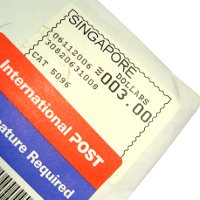How to Decipher an International Tracking Number
 Every international shipment is assigned a tracking number for the purpose of, well, tracking it. Parcel tracking tools look for the number in the shipping carrier’s database and return information about the current location of the shipment and its estimated time of arrival. For the system to work well, each international tracking number is unique and conforms to the S10 standard established by the Universal Postal Union.
Every international shipment is assigned a tracking number for the purpose of, well, tracking it. Parcel tracking tools look for the number in the shipping carrier’s database and return information about the current location of the shipment and its estimated time of arrival. For the system to work well, each international tracking number is unique and conforms to the S10 standard established by the Universal Postal Union.
The Universal Postal Union (UPU) is a specialized agency of the United Nationals tasked with coordinating the worldwide postal system. Most countries and territories of the world are members of the UPS; those that aren’t are represented there by a member state (Andorra is represented by Spain and France, and Micronesia, Palau and the Marshall Islands are represented by the United States).
To make tracking international postal items easier, the USU has developed an identification system used by all member states. The designated postal service of each member state is responsible for managing the issue and use of 13-character identifiers assigned to international shipments; all other postal operators are expected to cooperate with the designated service. The standard that regulates the identifiers is named S10.
An S10 identifier, colloquially known as tracking number, consists of 13 Latin characters and digits (two letters, nine digits, again two letters) and has four parts:
- Part 1 (two letters): service indicator code
- Part 2 (eight digits): serial number
- Part 3 (one digit): check-digit
- Part 4 (two letters): ISO 3166-1 alpha-2 country code
The service indicator code of a postal item indicates its type. These codes can range from AA to ZZ, but some code clusters aren’t used for international shipments, and some are reserved and cannot be assigned. An international tracking number can include one of the following service indicator codes:
- CA-CZ: parcel post (CV usually indicates an insured parcel); corresponds to the USPS Priority Mail International
- EA-EZ: express mail (EMS); corresponds to the USPS Priority Mail Express International
- HA-HZ: e-commerce parcels
- LA-LZ: letter post trackable; corresponds to the USPS First Class Mail International or Priority Flat Rate Envelope
- MA-M: letter post M-bags (printed matter)
- RA-RZ: letter post (registered, but uninsured); corresponds to the USPS Priority Mail International
- QA-QM: letter post IBRS (International Business Reply Service)
- UA-UZ: letter post other than express, M-bags, IBRS, registered, and insured; subject to customs control
- VA-VZ: letter post insured
The eight-digit serial number of every postal item is unique and cannot be reused within 12 calendar months. The UPU S10 standard recommends that serial numbers not be reused for a period of at least 24 calendar months.
The digit following the serial number is a check digit. To calculate it, the eight digits of the serial number are assigned the weights 8, 6, 4, 2, 3, 5, 9, 7, from left to right. Then each of the digits is multiplied by its weight, all results are added together, and their sum is divided by 11. The final result is subtracted from 11. If the difference is 9 or less, this is your check digit. If the difference is 10, the check digit is 0, and if it is 11, the check digit is 5.
The last two letters of an international tracking number identify the country of origin according to the ISO standard as defined in ISO 3166-1. For example, the final letters of all S10 identifiers assigned to postal items shipped from the United States are US.
Now that you know how to decipher an international tracking number you can, for example, make sure that the retailer has provided you with the right tracking number when you shop online. To track your international parcel, you can use the website of the postal operator or a third-party service, such as an online tracking tool provided by PostageMaker in addition to its other services (discounted shipping labels, an address book, a shipping calculator, and more).